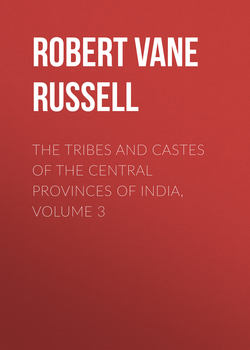Читать книгу The Tribes and Castes of the Central Provinces of India, Volume 3 - Robert Vane Russell - Страница 79
Gond
(g) Appearance and Character, and Social Rules and Customs
61. Clothes and ornaments
ОглавлениеIn Sir R. Jenkins’ time, a century ago, the Gonds were represented as naked savages, living on roots and fruits, and hunting for strangers to sacrifice. About fifty years later, when Mr. Hislop wrote, the Māria women of the wilder tracts were said only to have a bundle of leafy twigs fastened with a string round their waist to cover them before and behind. Now men have a narrow strip of cloth round the waist and women a broader one, but in the south of Bastar they still leave their breasts uncovered. Here a woman covers her breasts for the first time when she becomes pregnant, and if a young woman did it, she would be thought to be big with child. In other localities men and women clothe themselves more like Hindus, but the women leave the greater part of the thighs bare, and men often have only one cloth round the loins and another small rag on the head. They have bangles of glass, brass and zinc, and large circlets of brass round the legs, though these are now being discarded. In Bastar both men and women have ten to twenty iron and brass hoops round their necks, and on to these rings of the same metal are strung. Rai Bahādur Panda Baijnāth counted 181 rings on one hoop round an old woman’s neck. In the Māria country the boys have small separate plots of land, which they cultivate themselves and use the proceeds as their pocket-money, and this enables them to indulge in a profusion of ornaments sometimes exceeding those worn by the girls. In Mandla women wear a number of strings of yellow and bluish-white beads. A married woman has both colours, and several cowries tied to the end of the necklace. Widows and girls may only wear the bluish-white beads without cowries, and a remarried widow may not have any yellow beads, but she can have one cowrie on her necklace. Yellow beads are thus confined to married women, yellow being the common wedding-colour. A Gond woman is not allowed to wear a choli or little jacket over the breasts. If she does she is put out of caste. This rule may arise from opposition to the adoption of Hindu customs and desire to retain a distinctive feature of dress, or it may be thought that the adoption of the choli might make Gond women weaker and unfitted for hard manual labour, like Hindu women. A Gond woman must not keep her cloth tucked up behind into her waist when she meets an elderly man of her own family, but must let it down so as to cover the upper part of her legs. If she omits to do this, on the occasion of the next wedding the Bhumka or caste priest will send some men to catch her, and when she is brought the man to whom she was disrespectful will put his right hand on the ground and she must make obeisance to it seven times, then to his left hand, then to a broom and pestle, and so on till she is tired out. When they have a sprain or swelling of the arm they make a ring of tree-fibre and wear this on the arm, and think that it will cure the sprain or swelling.
